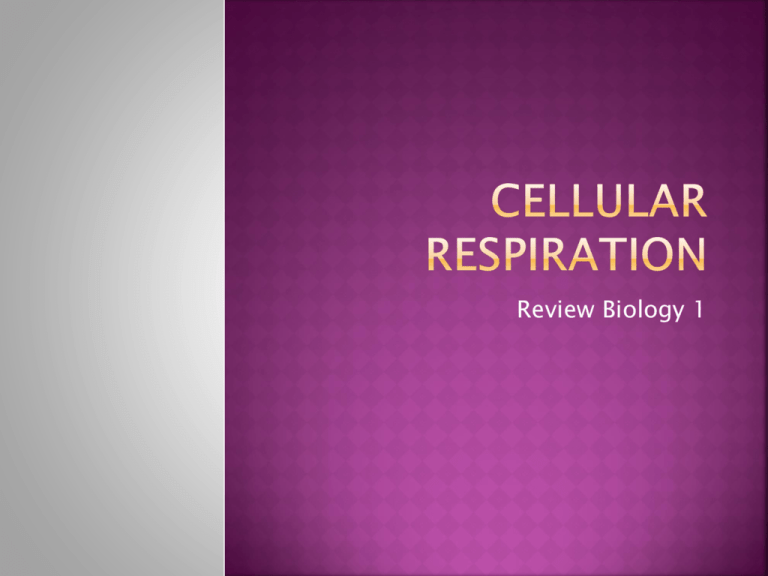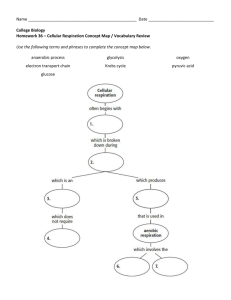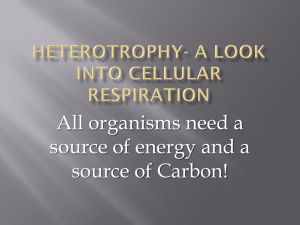2 Cellular Respiration
advertisement

Review Biology 1 Where does this occur in the cell? What is the “Power House” of the cell? Is this what keeps the cell alive? Is energy important to a cell? Does oxygen have to be present? Does the process change if there is no oxygen? What is the big deal? Why is this important? What do we need to know? Where does this occur? Do you remember what the powerhouse of the cell is? MITOCHONDRIA Is this what keeps the cell alive? Do we need energy to live? How do we get energy? What do we get energy from? Do the individual cells in our body have the same needs? Does oxygen have to be present in order for us (as humans) to breathe? How about for cells? Are there other processes that happen in the absence of oxygen? What is the big deal? Why is this important? Why do we need to know this? * Cellular Respiration Definition: Is a process . . . (takes time, doesn’t happen all at once) That releases energy. . . (ATP) By breaking down food . . . (in the form of glucose) In the presence of OXYGEN Oxygen + Glucose Carbon Dioxide + Water + Energy What is the first step? Glycolysis (Bonus– no oxygen required for this step!) Then what? Krebs Cycle -andElectron Transport Chain Energy . . . Energy. . . Energy. . . What is energy in a cell? ATP (ADP) Adenosine Triphosphate (Adenosine Diphosphate) (NAD+/NADH = electron carriers) (FAD/FADH2 = electron carriers) Glycolysis Definition: Is a process . . . (it takes time, more than one step) Where Glucose is broken in half . . . (food) Producing 2 molecules of Pyruvic Acid (which is used in the next step to create more energy!) This takes energy to get it going – It is like pedaling a bike . . . That first take off from a stop takes energy! (2 ATP used to break the glucose into 2 Pyruvic Acids) Now Glycolysis is done – 4 ATP was produced (total) 2 ATP was used to get the cell going – 2 ATP net (4-2) gained by the cell 2 molecules of Pyruvic Acid is formed (goes to the Krebs Cycle) 2 molecules of NADH formed (goes to the electron transport chain) Krebs Cycle Is Aerobic (Requires Oxygen) Occurs in the Mitochondria (Powerhouse of the cell) Breaks down Pyruvic Acid to Citric Acid Which is also broken down to: Carbon Dioxide, 2 ATP, . 4 NADH, 1 FADH2 What is NADH? NAD+ Nicotinamide Adenine Dinucleotide What is FADH2? FAD Flavine Adenine Dinucleotide What are the H’s? Hydrogens – High-Energy Electrons! At the same time: In the Electron Transport Chain (Still in the Power House – Mitochondria) (Still in the presence of Oxygen) Uses the NADH and FADH2 To convert ADP to ATP How does that happen? Remember that Hydrogens are HIGHENERGY electrons That ENERGY is captured by removing the Hydrogen from NADH and FADH2 Then transferred by adding a phosphate group to ADP – making ATP This is the energy used by our cells!!! From every molecule of Glucose – A total of 36 ATP are produced!!! 2 ATP from Glycolysis (outside the mitochondria) 34 ATP from Krebs Cycle and Electron Transport Chain (mitochondria) Do you now understand why the mitochondria is nick-named the Power House of the cell? So… what happens when there is NO oxygen for the cell to use? Fermentation There are two types: Alcoholic Fermentation Lactic Acid Fermentation Alcoholic Fermentation (anaerobic) Used by yeasts and other microorganisms Forms ethyl alcohol and carbon dioxide from the Pyruvic Acid created during Glycolysis. What is it that causes bread to rise? Why do bread recipes need sugar? What happens to the alcohol when baking bread? Lactic Acid Fermentation (anaerobic) Where does this occur? In our muscles!!!! As oxygen is used up in our muscles, the Pyruvic Acid created during glycolysis is converted to lactic acid. Feel the burn!!!





